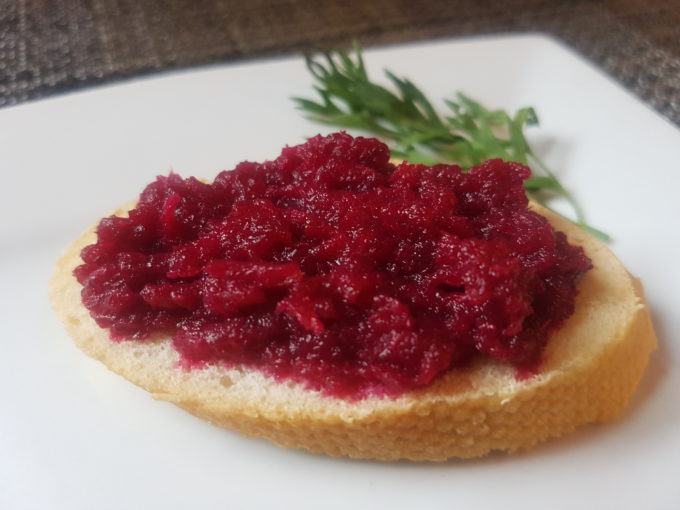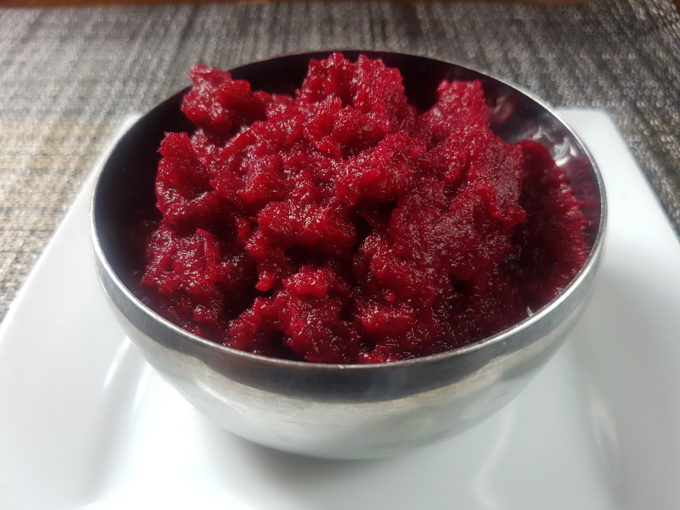 As Ćwikła in Poland or tsvikli (цвіклі) in Ukraine this relish, a combination of beets and horseradish, is very commonly used as a spread on sliced bread, and is in-fact so popular that it is sometimes referred to as Ukrainian Kimchi. In Russian, hron (Хрoн) means simply horseradish, but also usually refers to this relish with both horseradish and beets. It is also very similar to the Ashkenazi Jewish condiment Chrain.
As Ćwikła in Poland or tsvikli (цвіклі) in Ukraine this relish, a combination of beets and horseradish, is very commonly used as a spread on sliced bread, and is in-fact so popular that it is sometimes referred to as Ukrainian Kimchi. In Russian, hron (Хрoн) means simply horseradish, but also usually refers to this relish with both horseradish and beets. It is also very similar to the Ashkenazi Jewish condiment Chrain.
This Eastern European compliment is particularly common to find during Easter when it is served with ham or roasted suckling pig, however it also pairs well with other meats such as roast beef and pork tenderloin. Many vegetarians and healthy-minded folks prefer to use it throughout the year as a spread on sandwiches.
For a bit of History:
Although the propagation of beets first shows up in writing in 1542 from either Italy or Germany, it quickly became a staple for the more North-Eastern European cultures, as it is one of the only vegetables that grows well throughout the winter. Both the greens, the originally consumed part, and the taproot (what we simply refer to as root) can be eaten raw or cooked.
As for the Horseradish in this recipe, it’s use for medicinal purposes dates back to the 1500’s BC in Egypt where it then spread into Greek society. The name horseradish however, probably gets it’s roots (<— haha, like my pun?) originating from it’s German name meerrettich, meaning ‘sea radish’ since it grows by the sea. This perhaps evolved into mare-radish in English and then into our common title of horse-radish.
Either way, similarly to the beet, horseradish cultivation also quickly found it’s way from Central Europe north into Scandinavia, over to England, and eventually the American Colonies, where, by 1840 it could be found growing wild outside of Boston.
Also similar to the beet, horseradish is rugged and cold hardy. As a fall, winter, and even spring harvested vegetable it is easy to see why the two would end up becoming combined for such a wonderfully flavorful, colorful, and delicious spread.

As for this specific recipe:
- The beets in traditional Ukrainian “tsvikli” are grated. This makes for a nice texture along with the grated horseradish, but it is not uncommon to simplify the process using a food processor. I went traditional, but I leave it up to you to decide your personal preference.
- Lemon, apple cider, and/or white vinegar are all common as the acid in recipes. I have chosen a combination of apple cider for it’s sweetness and lemon juice for some zing, without being as aggressive as the tang of white vinegar.
- You will want some sort of sweetness to cut the zing. I use a small amount of white sugar although brown sugar or even honey/agave can be interchanged with subtle differences.
- It is not uncommon to see the addition of sour cream. More specifically this may mean smetana in Eastern Europe or crème fraîche in Western Europe.
- Lastly Spices. Everyone uses salt. Many leave it at that, while I have heard some folks say that cumin is absolutely essential. I have also seen recipes with only black pepper, while others have dill seed and coriander. Some simply say ‘mixed spices.’ Fresh garlic is also not a bad choice. Below I used just salt and pepper, but these are a few suggestions if you want to play with other flavors that you really like or may blend well with the rest of your dish or meal.
Beet and Horseradish Relish – Ćwikła/Tsvikli
By: semiserious chefs
Makes: ~2 cups
Ingredients:
- 5 medium beets; stems removed
- 1 fist sized piece of horseradish; 1/3 cup finely grated
- 1/4 cup apple cider vinegar
- 1/2 t lemon juice
- 1/4 t salt
- 1 t white sugar
- 1/8 t pepper
- Optional: dill seed/weed, coriander, or cumin as desired
Directions:
- Add enough water to a pot with a lid to cover the beets. Bring to a boil, and simmer heavily for 1 hour.
- Remove the beets and let cool to the touch. (Be sure to reserve the beet water for soup!) Rub the skins off the beets, then grate finely into a medium-sized bowl. Use gloves if you don’t want stained hands.
- Cut the surface skin off the horseradish root, and shred on the finest mince blade of a grater. Add to the bowl with the beets.
- Add the vinegar, lemon juice, sugar, salt, pepper, and spices if using to the beet and horseradish mixture.
- Stir well and it’s ready to serve!


One comment on “Ćwikła/Tsvikli/Chrain – Beet and Horseradish Relish”
I chose to maintain the nutritional integrity of the beets by shredding and keeping them raw. After incorporating the remaining ingredients, I gently pressed the mixture, reserving the liquid. I served the pressed juice as a cocktail with a pickled okra garnish. Vodka or gin can be added to the cocktail as an option.